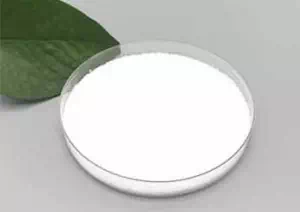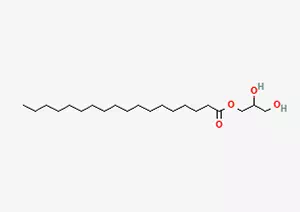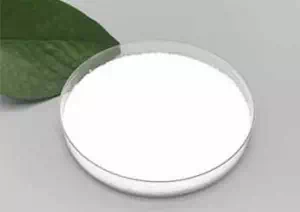All Categories



monostearin CAS 123-94-4, monostearin, CAS 123-94-4
In the vast field of chemistry, the substance monoglyceride (MG) has its unique identity and characteristics. It is actually the full name of monostearin (or glycerol monofatty acid ester).
CAS : 123-94-4
Formula : C21H42O4
Mol. wt. : 358.56
EINECS : 204-664-4
Chemical Name | Monostearin |
Other Name | Glyceryl stearate; Glycerin stearic acid; Glycerol monostearate; Glycerolmonostearat |
CAS | 123-94-4 |
EINECS | 204-664-4 |
Type | Food additives; Pharmaceutical raw materials; Organic raw materials |
Molecular Formula | C21H42O4 |
Molecular Weight | 358.56 |
In the vast field of chemistry, the substance monoglyceride (MG) has its unique identity and characteristics. It is actually the full name of monostearin (or glycerol monofatty acid ester). It is worth noting that there are two different Settings of monoglycerides, namely what we call 1-MG and 2-MG. These two Settings may have some subtle differences in their chemical structures and related properties, which together constitute the rich connotations of monoglycerides.
When we further explore monostearic acid, we will find that it can be classified in detail according to the names of its main component, fatty acids. According to this classification method, monostearic acid can be divided into different categories such as monostearic acid glycerol, monolauric acid glycerol, and monooleic acid glycerol. Among these numerous classifications, monostearic acid glycerin is undoubtedly the one that is most widely used in the manufacturing process. Glycerol monostearate usually appears oily, fatty or waxy in appearance. Its color is mostly light yellow or milky white, and it basically has no special odor, presenting a relatively pure state. The reason why it presents such characteristics is closely related to the size and saturation of the aliphatic groups. Different sizes and saturation of aliphatic groups work together to shape the appearance and odor features it has today. At the same time, it also has excellent sensory characteristics, which enables it to demonstrate unique advantages in numerous application scenarios.
In addition, monostearin has a special "identity"; it is a polyole-based nonionic surfactant. From the essence of its chemical structure, due to the presence of lipophilic long-chain alkyl groups in its skeleton structure and the addition of two hydrophilic hydroxyl groups, this unique structure endows it with excellent surface area task capacity. With this special structural advantage, it also possesses a series of very practical characteristics, such as emulsification function, which enables substances that were originally difficult to blend to be evenly mixed together. Foaming function, which can generate fine and stable foam in certain specific scenarios; The dispersion function enables substances to be better dispersed in the medium. The defoaming function plays a significant role when it is necessary to eliminate foam interference. And it has properties such as anti-starch aging. It is precisely for this reason that it has become one of the most commonly used emulsifiers in the food and cosmetics industries, adding a guarantee to the quality and user experience of many products.
Moreover, the application fields of monostearin are far from limited to this. It also has important uses in the pharmaceutical field. For instance, glycerides of polyunsaturated fatty acids (EPA, DHA) have the function of preventing cardiovascular diseases, and monostearin may also play an indispensable role in this process, facilitating medical research and development as well as disease prevention and treatment efforts. In addition, in the field of polymer synthesis, monostearic acid glycerol has also been widely applied, providing strong support for the related research and development of polymer synthesis and contributing its share to the progress of the entire chemical-related industry.
In today's rich and diverse industrial fields, monostearin has demonstrated its extremely extensive and significant application value, especially in the cosmetics industry, which is closely related to People's Daily lives, where it plays an indispensable role.
In the cosmetics industry, the application of monostearin is particularly prominent, especially in personal care products such as shampoo and body wash that people frequently use in their daily lives. When we walk into the supermarket shelves and look around, there are a wide variety of shampoo and body wash brands, and a large proportion of them have added monostearin. In shampoo, monostearin can work in synergy with other ingredients to help regulate the texture of the product, making it neither too thin to control the amount used nor too thick to affect the application and rinsing effect during use. At the same time, it can also assist in removing dirt and grease during the hair cleaning process, keeping the hair fresh and smooth after washing. In bath products, monostearin also plays a crucial role. It can make the body wash produce rich and fine foam. These foams not only enhance the pleasure of bathing but also clean the skin more effectively. Moreover, they do not leave any residue on the skin after rinsing, making the skin feel fresh and comfortable.
Monostearol also has extensive applications in multiple fields. In the food or cosmetic sectors, it plays a crucial role as an emulsifier and surfactant. In the food industry, when we taste some processed foods, we may not be aware that monostearol is playing a silent role in them. It can help the components that are immiscible with oil and water to mix evenly together, making the texture of the food more stable and fine. For instance, in some dairy products and baked goods, the presence of monostearol can prevent the separation of oil and water, extend the shelf life of food and maintain its good taste. In cosmetics, monostearol, as an emulsifier, can ingeniously blend various oily and water-based components together to form a stable emulsion system. For instance, in products such as face creams and lotions, it can ensure that the products do not stratify or deteriorate during storage and use, allowing the efficacy of cosmetics to be fully exerted.
In addition, monostearol is also an internal and external lubricant for plastic products. During the plastic processing, when plastic particles are heated and melted and injected into the mold for shaping, monostearol acts like a silent "lubricating assistant", forming a lubricating film between the plastic particles and between the plastic and the mold surface. This lubricating film can effectively reduce the friction between plastic particles and the adhesion between plastic and molds, enabling plastic to flow and form more smoothly, thereby improving the production efficiency and quality of plastic products. At the same time, it can also improve the surface smoothness of plastic products, making the appearance of the produced plastic products smoother and more beautiful.
Monostearin also has unique applications in the field of gas chromatography. In gas chromatography analysis, it is used as a stationary liquid, dispersant and emulsifier. When researchers conduct complex chemical substance analyses, monostearin can help separate and analyze substances such as oxygenated compounds and volatile oils. For instance, in some fields such as drug development and environmental monitoring, gas chromatography technology is an indispensable analytical method, and monostearin plays a crucial role in it. It can interact with the sample to be analyzed under specific temperatures and conditions, enabling different components to separate according to certain rules, thereby providing accurate and reliable analysis results for researchers.
In the pharmaceutical industry, monostearin also holds an important position. It can be used as an auxiliary component in drug preparations to help the drug take shape and stabilize better. For instance, in some tablet drugs, monostearin can act as a lubricant, reducing the friction between drug particles, making the tablet pressing process smoother, and at the same time improving the quality and stability of the tablets. In the field of biochemical research, monostearin also has extensive applications. It is often used in various experiments as a thickener for margarine, which can make margarine have the appropriate hardness and consistency, simulate the taste and texture of natural butter, and provide convenience for food research and related studies.
Monostearin is also an excellent solvent for oil and wax. In some processes that require the dissolution of oil or wax, it can demonstrate outstanding dissolving ability. At the same time, it is also a protective agent for hygroscopic powders, which can prevent hygroscopic powders from absorbing moisture from the air and forming lumps or deteriorating, ensuring the stability and usability of the powders. Among sunscreen products, monostearin, as one of the main ingredients of opaque sunscreens, can effectively reflect and scatter ultraviolet rays, protecting the skin from ultraviolet damage. In the field of gas chromatography stationary solutions (with a maximum operating temperature of 125°C and hot ethanol as the solvent), it can achieve precise separation and analysis of oxygenated compounds and volatile oils, providing strong support for scientific research and industrial production.
Not only that, monostearin is also an important demulsifier and preservative in the food industry. During the food production process, when the emulsification of oil and water occurs and affects product quality, monostearin can play a demulsifying role, separating oil and water to ensure the normal production and storage of food. Meanwhile, it can also inhibit the growth and reproduction of microorganisms, extend the shelf life of food, and ensure the safety and hygiene of food. In skin care products and medicinal plasters, monostearin also plays an important role as a demulsifier. It can make the structure of the paste more delicate and smooth, enhancing the user experience and efficacy of the product. For instance, in some moisturizing skin care products, monostearin can make the cream easier to apply and form a protective film in a short time, locking in the moisture of the skin and keeping it hydrated.
In industrial production, monostearin also has many important applications. In silk degreasing agents, it is an indispensable demulsifier, which can help remove oil impurities on the surface of silk, while protecting the fiber structure of silk from damage, making silk softer and smoother. In textile products, monostearin, as a lubricant, can reduce the friction between fibers during the textile process, improve textile efficiency and product quality. In the production of plastic films, monostearin can be used as a dripping agent and anti-fogging agent. As a dripping agent, it can control the fluidity of plastic films during the production process and ensure the uniform thickness of the films. As an anti-fogging agent, it can prevent the phenomenon of fog condensation in plastic films during use, maintaining the clarity and transparency of the films. During the plastic granulation process, monostearin also serves as a lubricant and antistatic agent. It can reduce the friction between plastic particles and the generation of static electricity, making the granulation process smoother. At the same time, it can also improve the quality and performance of plastic particles.
In addition, monostearin also plays multiple roles such as defoaming agent, thickener, emulsifier and wetting agent at other levels. In numerous fields such as chemical production, food processing, and daily necessities manufacturing, it has made significant contributions to the improvement of product quality and performance with its unique properties and wide applicability.
Melting point | 78-81 °C |
Boiling point | 476.9±25.0 °C(Predicted) |
Density | 0.9678 g/cm3 |
Storage temp. | -20°C |
* Prompt reply and 24 hours online, professional team to provide best price and high quality product.
* Sample testing support.
* Every batch of products will be tested to ensureits quality.
*The packing also can be according the customers` requirment.
*Any inquiries will be replied within 24 hours.
*we provide Commerical Invoice, Packing List, Bill of loading, COA , Health certificate and Origin certificate. If your markets have any special requirements, let us know.